“The padhigam I am going to teach you today is Angamum Vedhamum…” said my Guruji, Mrs. Shyamala Krishnadas. Later that evening, while researching that Thevaram, I came across two temple towns—Thirumarugal and Thiruchengattankudi. What brilliance the child saint Thirugnanasambandar had, composing verses that beautifully wove together two places so close to each other!
Thiruchengattankudi rang a bell, although I had never heard of Thirumarugal before. And then, a flash of memory struck. I quickly pulled out my copy of Kalki’s Sivagamiyin Sabadham and turned through the pages. Yes—there it was! Paranjothi, the valiant general of King Narasimhavarman Pallava, after his victorious campaign at Vatapi (present-day Badami), wished to bring back a Ganesha idol and install it in his hometown, Thiruchengattankudi.
“We must go to these two places…” I declared to Senthil, who was deeply absorbed in the morning newspaper.
“Ok… find out where they are…” he replied casually.
“Yes, I will. But first, let me read up more about them.”
The trip finally materialized in June 2025. Since Thirukadaiyur is always close to our hearts, we chose to stay there and planned a drive to the two temple towns via Karaikal. After breakfast at Karaikal, we began asking around for directions to Thiruchengattankudi. Surprisingly, very few people seemed to know about it! As is Senthil’s custom, he headed straight to an IOC petrol station and, true to form, the attendants there gave us the correct guidance. Google Maps also takes you there without a hitch.
The winding road stretched ahead, lined with fields swaying in the summer breeze. To set the mood, I played Mylai Sadhguru Nadhar’s Painkottu Malar Punnai Thevaram. The car instantly filled with the soulful notes of the Panchamam Pann, and as always, Senthil began to hum along, matching the rhythm. Thirugnanasambandar sang this Thevaram at Thiruchengattankudi.
Thiruchengattankudi, our destination, is also known as Ganapatheeswaram. Legend has it that a demon named Gajamukhasuran, with the head of an elephant, once wreaked havoc in this region. To protect the people, Lord Shiva sent his son, Ganesha. A fierce battle followed, shaking the very land, until Ganesha struck the final blow and killed the asura. The demon’s blood flowed like a river, staining the earth red—hence the place came to be called Chenkaadu (the red forest).
After the victory, however, Ganesha felt the burden of taking a life—even if it was that of a demon. In deep devotion, he prayed to his father, Lord Shiva, here at this very place. Moved by his son’s sincerity, Lord Shiva appeared and took the name Ganapatheeswarar—the Lord who was worshipped by Ganesha himself.

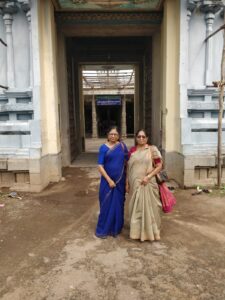


Within the temple, there is also a sannidhi for Lord Shiva as Bikshadana, depicted in a graceful standing posture. After we had a darshan of Ganapatheeswarar, we were ushered in by the priest to the Uthirapatheeswarar sannidhi. There were some locals also having darshan and they stepped aside and remarked to us that this sannidhi was the most important section in this temple. They were happy that outsiders had come from afar to witness and with a sense of pride stood beside us. The story behind this Panchaloha murthy is both fascinating and profound. Could not take pictures but sharing a painting which we found on a wall.

It is said that King Kadavarkon once desired an idol of Bikshadanar to be crafted and summoned skilled sculptors for the task. But no matter how much they tried, they struggled to capture the divine form correctly. At that moment, a humble Shiva Yogi appeared before them and asked for water. Irritated by the interruption, the weary sculptors retorted harshly, “We have only molten metal here—drink if you wish!”
To their astonishment, the yogi calmly drank the molten metal—and in that instant, transformed into the radiant form of Bikshadana himself. That divine form stands here even today as the temple’s Panchaloha idol. Beneath the fig tree inside the temple, one can still see the spot where the yogi is believed to have meditated.
This legend reminded me of another tale—of molten metal giving life—connected with Asia’s largest Nataraja idol, which stands tall in Konerirajapuram near Kumbakonam. The echoes of these stories show how faith and divinity manifest in miraculous ways across our sacred land. This form of Shiva, the Bikshadanar is known as Uthirapatheeswarar in this temple.
My eyes were drawn to the idols of Siruthondar Nayanar, his wife Thiruvenkadu Nangai, their little son Seeralan, and their devoted maid Sandhana Nangai. These idols stand as a reminder of one of the most hair-raising, horrific yet divinely profound leelais of Lord Shiva.

Before I narrate the story, a little context: Siruthondar Nayanar, one of the 63 revered Nayanmars, was none other than Paranjothi—the army general of Pallava King Narasimhavarman, whose exploits are vividly chronicled in Kalki’s Sivagamiyin Sabadham. One of the reasons I longed to visit Thiruchengattankudi was because it was his birthplace. To walk upon the same soil where Paranjothi was born felt deeply humbling.
The sannidhi here bears long lines of inscriptions, perhaps recounting how Paranjothi, after the bloody wars and countless killings, renounced his past as a warrior and turned into a humble servant of Lord Shiva. As Siruthondar Nayanar, he made a solemn vow: he would never eat a meal without first serving a Sivanadiyar, a devotee of Shiva.
One day, however, no devotee could be found. He searched desperately until finally, a fierce-looking Sivanadiyar, a Bhairavar, arrived at their home, demanding food. Siruthondar’s heart leapt with joy that he could serve him. But the ascetic’s demand was terrifying—he declared that he would eat only the flesh of a five-year-old boy.
What followed was beyond imagination. Yet, with sorrow in their hearts and faith in their Lord, Siruthondar and his family obeyed the request. Their beloved five-year-old son, Seeralan, was killed and cooked by their maid Sandhana Nangai, and the curry was served upon a banana leaf before the ascetic.
Just as they thought the ordeal was over, the ascetic demanded thalai curry—the boy’s head as well! Siruthondar was shaken to his core, but Sandhana Nangai, with remarkable composure, had already kept the head aside. She quickly cooked it, and Thiruvenkadu Nangai herself placed it before the ascetic.

But the ascetic was not done. He now declared, “I will eat only if you join me.”
Siruthondar Nayanar was made to sit with the ascetic and began eating the curry. But then, the Bairava said, “Stop… call your son to join us.”
Shock froze everyone in place. How could little Seeralan come, when he lay there on the banana leaf as a curry?
The Bairavar repeated, “Call him now.”
Not knowing what else to do, Siruthondar went outside and called, “Seerala… Seerala… come and eat!”
And, wonder of wonders, little five-year-old Seeralan ran towards him as if returning from school. Siruthondar scooped him up and rushed inside—only to find the Bairavar had vanished without a trace.
A bright light suddenly filled the space, and they all beheld a divine darshan of Lord Shiva, Goddess Parvathy, and Lord Muruga seated on Nandi. On that day, the entire family attained mukthi, eternal bliss, and became one with the divine.
This is not mere imagination—it is recorded in the Periya Puranam and depicted in sculptures on the walls of many temples. The story reminds us that the Lord sometimes tests the depth of our devotion, asking if we are willing to surrender everything, even our most precious loved ones, for Him.
The most important utsavam in this temple is celebrated in the month of Chithirai on Barani star day to remind people of how Siruthondar offered “pillai curry” to Lord Shiva. Lots of people come from far and near for this festival. The prasadam called “amudhu padayal” is special especially for couples unable to have children. Belief is Lord Uthirapatheeswarar will fulfill their desire of becoming a parent once they eat this prasadam.
Standing there in the sannidhi, I felt a quiet reverence wash over me. Walking the same ground where Siruthonda Nayanar once lived and offered everything to the Lord made me reflect deeply on devotion, surrender, and the mysterious ways of the divine.
Am I ready to give up what is close to my heart? Hmm. Perhaps I have several more lives to live to reach that stage!
The temple was practically empty, allowing us to spend a long time at each sannidhi, basking in the divine vibrations.
One unique aspect of this temple is that Vatapi Ganapathi, Uthirapatheeswarar, and the Goddess Vaitha Thirukuzhali have only two hands, unlike most temples where they are depicted with four. Amma and I lingered at the Vatapi Ganapathi sannidhi, tracing the inscriptions with our fingers. Being ardent Kalki fans, we could almost visualize how Paranjothi aka Siruthondar’s wishes had been fulfilled here. This is the famous Vatapi Ganapathi, which inspired Muthuswami Dikshitar to compose the keertana, Vatapi Ganapathim bhajeham that is very popular today. Some academics say that this Vatapi Ganapathi was taken to Thiruvarur and installed there. Yet, standing there, I truly believed that this must be the Vatapi Ganapathi which Paranjothi must have brought and installed!
There were 32 inscriptions in total, and it is said that most of the temple was built under the guidance of Thennavan Moovendha Velaan, the able manager of Raja Raja Chozhan.

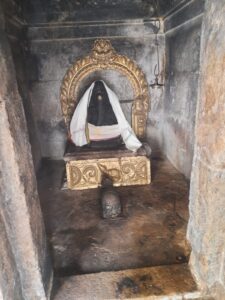



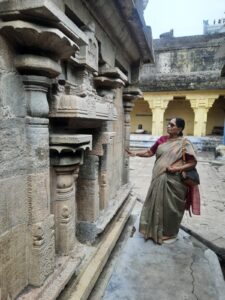

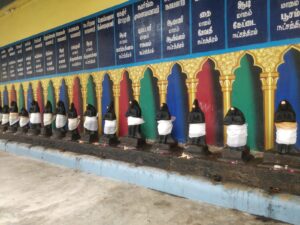
While doing the pradhakshina, I noticed a raised enclosure. It was impossible for Amma to climb, so I went up the steep steps alone—and I was not disappointed. There stood the Nava Thandava Murthies (it was labelled), all perfectly chiselled. I remembered reading that Shiva Thandava Murthies are generally said to be seven, sometimes sixteen—but here, there were nine. Kalasamhaarar, Gangaalar, Bikshadanar, Oorthva Thaandavar, Bujangalalithar, Gajasamhaarar, Tripurasamhaarar, Bairavar, and Uthirapathiyaar made it nine, a unique configuration.




I quickly started clicking pictures and videos of the Nava Thandava Murthies—well, some of them were not dancing murthies, but why go into that debate. They were sure enough a feast for the eyes.
As I carefully descended the steps of the raised enclosure, a memory came to me—I had read a book by Bhaskara Thondaimaan that this temple holds a special significance. It is said that worshipping here in the morning cleanses all sins, in the afternoon dissolves all sorrows, and in the evening, the most auspicious time, even the burdens of seven lifetimes are lifted.
Next time, I must worship in the evening, I thought to myself, while clicking pictures of the Rajagopuram before walking to the car to set off for our next destination, the town of Thirumarugal.
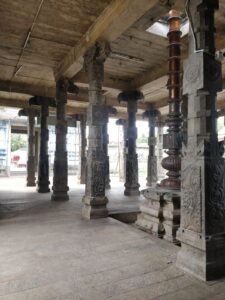
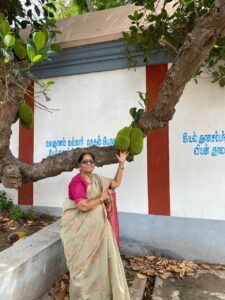


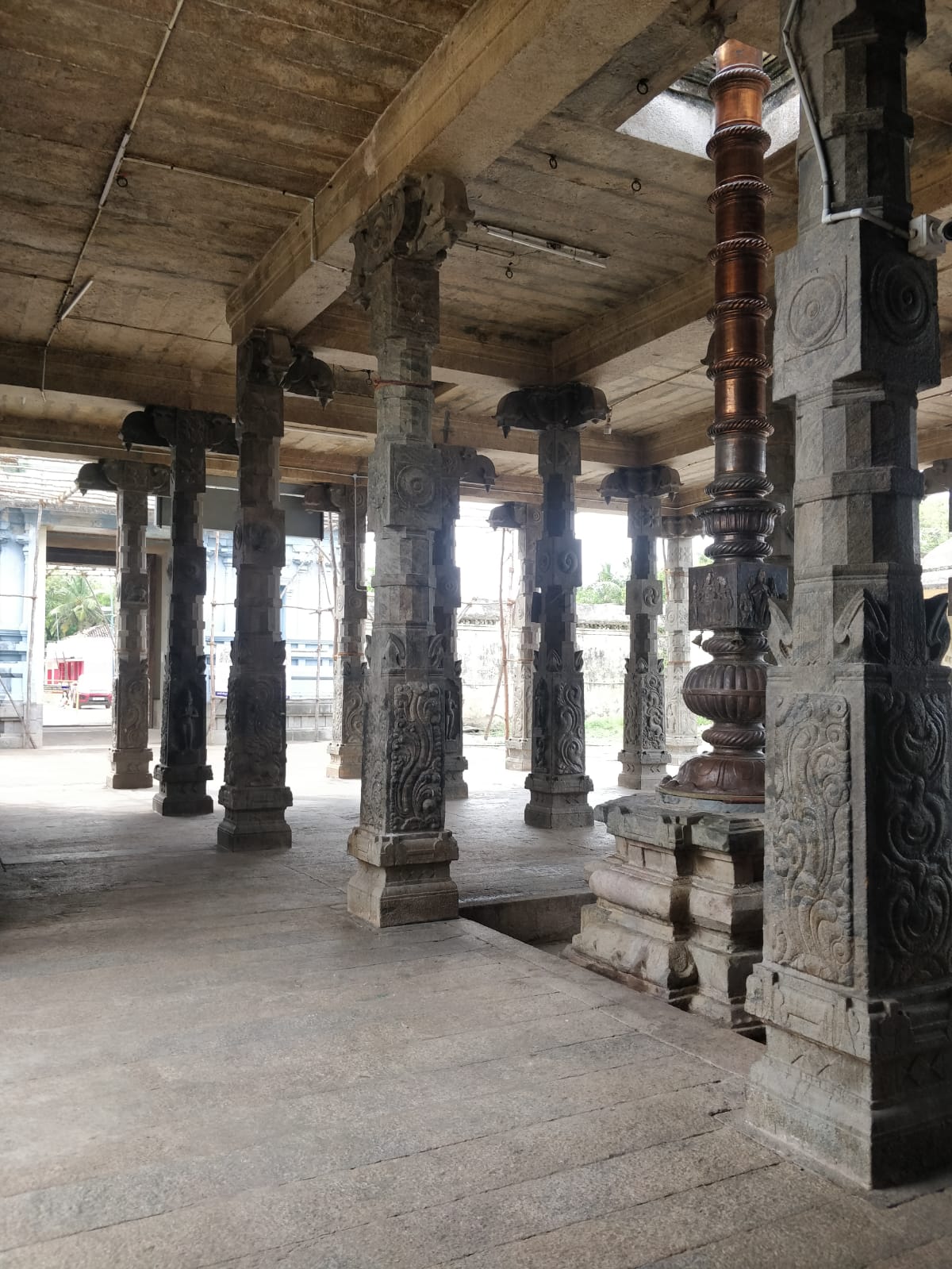
The facts about the temple are presented so beautifully. Many of us were unaware of the existence of such a historical place. It will certainly be part of my future travel itinerary, thanks to you. Please do continue sharing your writings.
The pictures and historical backgrounds and their links with the builders as well as the poets who have written in the poetic style are so absorbing , all making it hard to analyze in the very little time allocated in ones life, I’m wondering how the maidan visit could’ve given you the ability to describe them in such a versatile manner bringing in everyone’s mind such picturesque views. This is simply amazing. Perhaps you have a divine powers at that.👌🙇♂️🙏🏼
Sitting in Austin, TX, as a fresh morning read, I relished every bit of your travelogue. Brilliant weaving of Kalki’s Sivakamiyin Sabhadham, made the characters walk alive along with the narrator. Particularly Paranjothi who also comes in Kalki’s “Paarthiban Kanavu”, re-lives through your writing, in his later realised avatar of Siruthondar. Thoroughly enjoyed and eagerly looking forward to the next part on Thirumarugal. Keep it flowing!
Wow, your post about the old temples is fascinating! It is really an information to learn more about the deities and the stories behind them.Your writing brought the history and culture to life, specially the Paranjothi’s story of Pallava dynasty. You are such a great story teller and a writer about many temples.A great service to Hinduism! Good luck, keep it up, my blessings
I love how well you chronicle your visits to the temple, and also the stories and myths behind each of them 🙂 even if we (the younger generation) don’t read the original tests, we will know the stories now
Aishwarya that’s precisely why I want to chronicle them in a simple writing style so that it reaches people like you. There are so many treasures like this all over India which many are not aware of. Thnx for reading
I thoroughly enjoyed reading this post, Megha. Thank you for making the effort to share the history and the significance of the temple. I held my breath as I read through Siruthonda Nayanar’s sacrifice, faith and devotion. I literally feel like I am strolling the temple seeing through your eyes and transported there through your words. Looking forward to your next post! Keep them coming!
Interesting read Meghu.. the depth of research and devotion is very evident in your in your stories
Wow! What a story! As always, you sure bring the Temple precincts live into the reader’s mind with your fabulous narration.
The efforts that you put in to research every aspect of the Temples that you visit are commendable beyond words.
Blessed to read and absorb the glorious historical past from the confines of one’s drawing room.
Thank you,Mega. Keep writing.
God Bless
Nice read.
Especially touched by the total surrender of Siruthondar Nainaar.
That’s the kind of faith that moves mountains and brings dead children back to life.
Keep going, Megu !
A fascinating account of your travel to this sacred place 🙏🙏 Thank you for sharing.
[…] If you have missed reading about my visit to Thiruchengattankudi, click here. […]